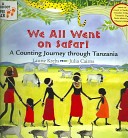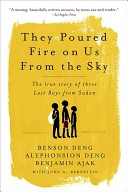
Follows a Tanzanian family through the African grasslands as they count the animals they see, from one leopard to ten elephants; includes information about Tanzania and Swahili names and numbers.
Materials from Africa

Follows a Tanzanian family through the African grasslands as they count the animals they see, from one leopard to ten elephants; includes information about Tanzania and Swahili names and numbers.

For years, people on the secluded island of Madagascar told scary stories about a mysterious creature called the fossa. According to some, this vicious killer crept out of the forest at night to steal babies from their cribs. Few people, however, had actually seen this rare animal. Were the stories true? Scientist Luke Dollar was about to find out. In 1996, he set up camp in Madagascar to study these mysterious and misunderstood creatures– and finally learn the truth. In Fossa: A Fearsome Predator, kids follow Dollar as he discovers the secrets of this fascinating, uncommon animal. Large, full-color photos and a narrative format will keep readers turning the pages for more.

Africa is home to some of the animal kingdom’s most ferocious hunters and savages. Whether screeching through the rainforests, prowling the wide savannas, or lurking along rivers, these brutes make shrot shrift out of all who dare cross their paths. To dominate their realms and evade attackers, some beasts use massive strength and vicious claws while others rely on impressive speed and cunning tricks. What equipment and skills would you need to survive? Jump in and find out!

Anansi the Spider is one of the great folk heroes of the world. He is a rogue, a mischief-maker, and a wise, lovable creature who triumphs over larger foes. In this traditional Ashanti tale, Anansi sets out on a long, difficult journey. Threatened by Fish and Falcon, he is saved from terrible fates by his sons. But which of his sons should Anansi reward? Calling upon Nyame, the God of All Things, Anansi solves his predicament in a touching and highly resourceful fashion. In adapting this popular folktale, Gerald McDermott merges the old with the new, combining bold, rich color with traditional African design motifs and authentic Ashanti language rhythms.

“Provides comprehensive information on the geography, history, wildlife, governmental structure, economy, cultural diversity, peoples, religion, and culture of Angola”–Provided by publisher.

A five-thousand-year-old story.When the godchild Atum emerges from inky silence to begin his work of creation, he first conjures up the passionate gods of air and rain, followed by Geb, god of the earth, and Nut, goddess of the sky. But earth and sky cling to each other, sharing whispered secrets and laughter, leaving Atum no room to complete his creation. So Atum has no choice but to force them apart, infuriating Geb and leaving Nut sad and lonely . . . until Thoth, the god of wisdom, takes pity on her.

Come gather round, young and old, and hear these stories from Africa, retold and illustrated by the incomparable Ashley Bryan. The fourteen stories in this collection are some of his favorites, previously published in The Ox of the Wonderful Horns; Beat the Story-Drum, Pum-Pum (Coretta Scott King Award for Illustration); and Lion and the Ostrich Chicks (Coretta Scott King Honor Book).Retold with rich, musical narration, and illustrated with Mr. Bryan’s distinctive paintings, these tales are full of fun and magic and a few lessons to be learned. They are tales of tricksters, chieftains, and both wise and foolish creatures. You will learn why Frog and Snake never play together, or why Bush Cow and Elephant are bad friends, or of the problems that a husband has because he likes to count spoonfuls. Although the stories come from many parts of Africa, they are full of the universal human spirit, to be shared and treasured for every generation, uh-huh.

Benjamin, Alepho, and Benson were raised among the Dinka tribe of Sudan. Their world was an insulated, close-knit community of grass-roofed cottages, cattle herders, and tribal councils. The lions and pythons that prowled beyond the village fences were the greatest threat they knew. All that changed the night the government-armed Murahiliin began attacking their villages. Amid the chaos, screams, conflagration, and gunfire, five-year-old Benson and seven-year-old Benjamin fled into the dark night. Two years later, Alepho, age seven, was forced to do the same. Across the Southern Sudan, over the next five years, thousands of other boys did likewise, joining this stream of child refugees that became known as the Lost Boys. Their journey would take them over one thousand miles across a war-ravaged country, through landmine-sown paths, crocodile-infested waters, and grotesque extremes of hunger, thirst, and disease. The refugee camps they eventually filtered through offered little respite from the brutality they were fleeing. In They Poured Fire on Us From the Sky, Alepho, Benson, and Benjamin, by turn, recount their experiences along this unthinkable journey. They vividly recall the family, friends, and tribal world they left far behind them and their desperate efforts to keep track of one another. This is a captivating memoir of Sudan and a powerful portrait of war as seen through the eyes of children. And it is, in the end, an inspiring and unforgettable tribute to the tenacity of even the youngest human spirits.

When Gervelie was born in 1995 in the Republic of Congo, her mother and father had a nice house in a suburb of Brazzaville. When fighting broke out two years later, her father’s political connections put the family in grave danger and they were forced to flee. Gervelie’s Journey follows the family from Congo to the Ivory Coast, and then to Ghana, across Europe, and finally to England. Told in Gervelie’s own voice and using her own photographs, it depicts with grace and sensitivity their long journey, their life in a new country, and their hopes for the future.

He was named “Sham” for the sun, this golden-red stallion born in the Sultan of Morocco’s stone stables. Upon his heel was a small white spot, the symbol of speed. But on his chest was the symbol of misfortune. Although he was swift as the desert winds, Sham’s pedigree would be scorned all his life by cruel masters and owners.
This is the classic story of Sham and his friend, the stable boy Agba. their adventures take them from the sands of the Sahara. to the royal courts of France, and finally to the green pastures and stately homes of England. For Sham was the renowned Godolphin Arabian, whose blood flows through the veins of almost very superior thoroughbred. Sham’s speed — like his story — has become legendary.